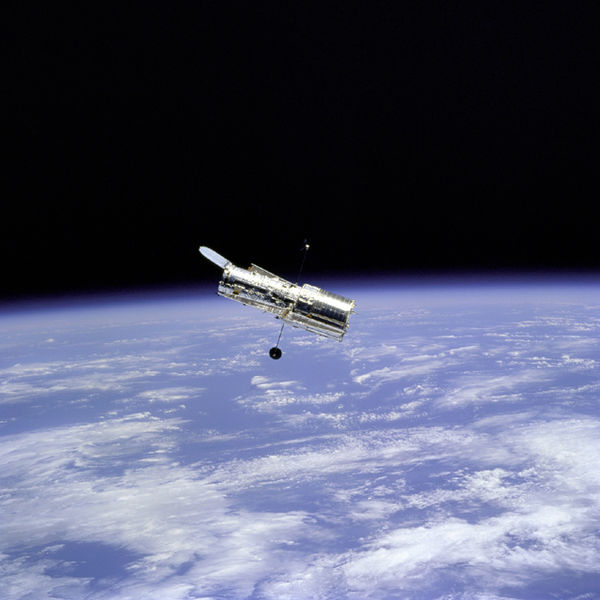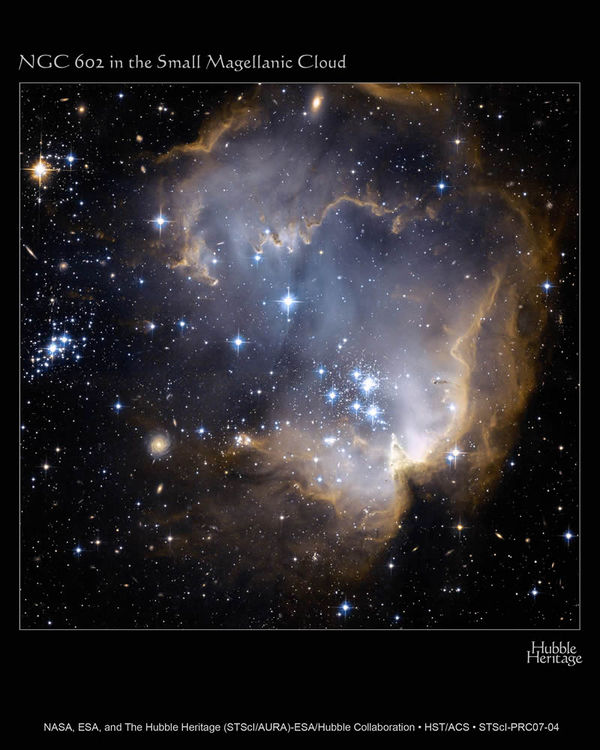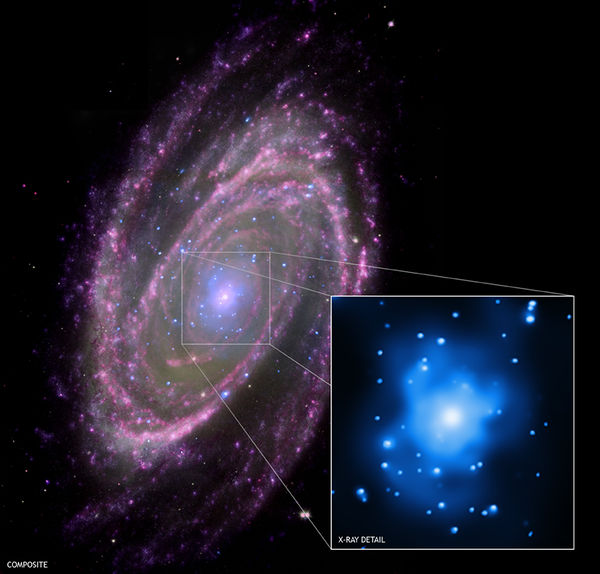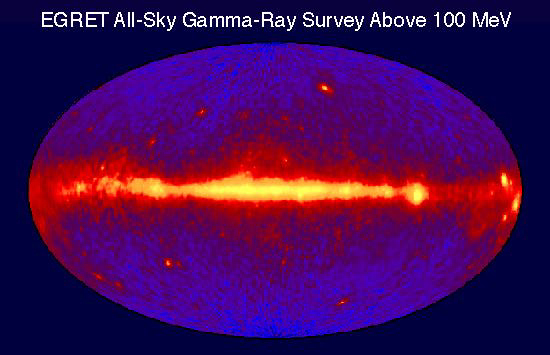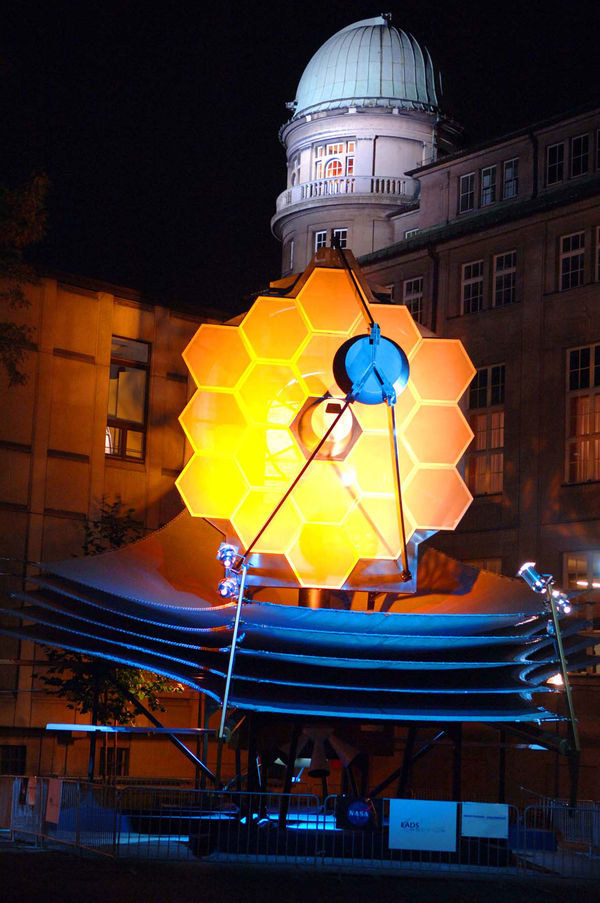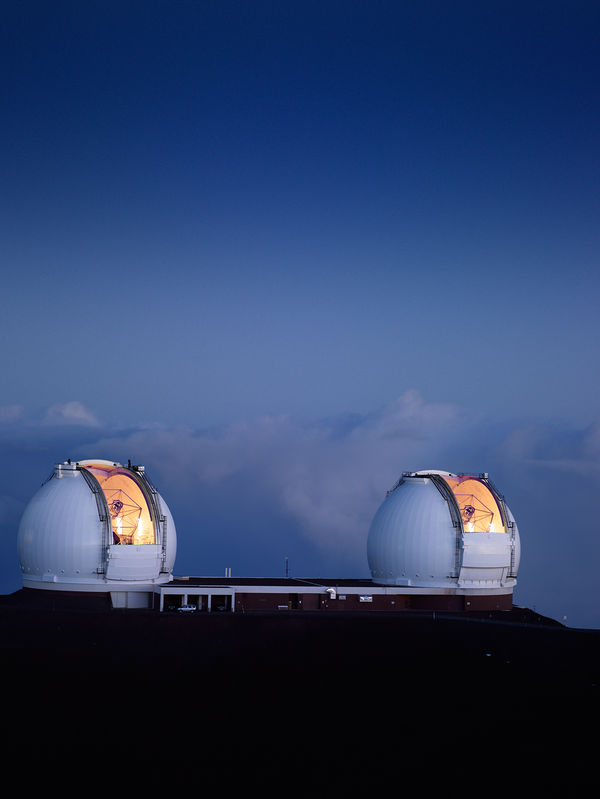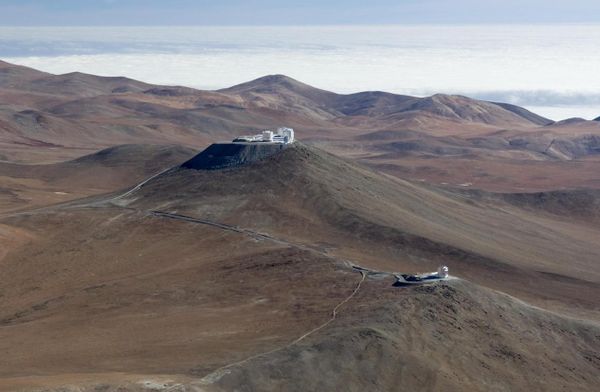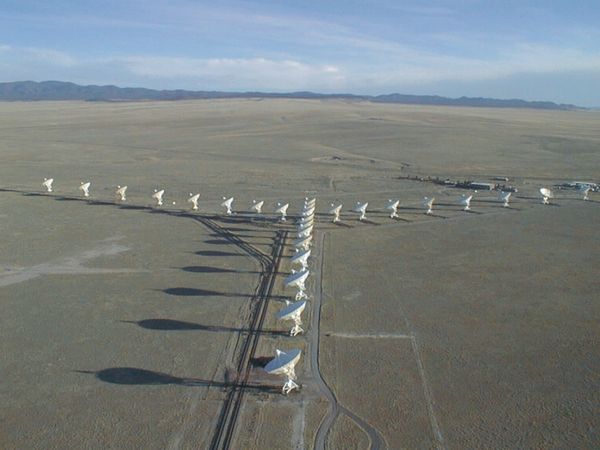Telescopes
Telescopes on Earth and in space are the astronomer's primary tools to gather information about the universe. You are probably familiar with small telescopes and binoculars, and indeed Galileo, the first astronomer to use a telescope, had one not nearly as good as those amateur astronomers use today. In this unit we will take a look at the telescopes astronomers use for research. They range in size from small ones such as we have at the University of Louisville observatories, to the largest on mountain ranges in Hawaii and Chile. There are plans to build even larger ones because the bigger the telescope, the more light they gather and the more detail they can record. This site lists some of the largest telescopes in use now and under construction.
Hubble Space Telescope
Not the largest, but by far the most productive telescope ever, the Hubble Space Telescope is known for its extrordinary discoveries. It is in low orbit, circling every 96 minutes about 560 km above the Earth's surface, and beyond Earth's atmosphere. The Hubble can record images and spectra from the near-infrared to the ultraviolet without the blurring effects of Earth's atmosphere, the absorption of infrared and ultraviolet caused by atmospheric gases, or the disturbing effects of urban lighting.
Hubble Space Telescope
The Hubble Space Telescope (HST) has produced the most detailed, dramatic, distant images of the heavens in history. All of them may be found at Hubblesite. Specific categories are in the list to the left under News Release Archive.
Hubble image of NGC 602
Information on the images produced by the Hubble Heritage Team may be found at their gallery. Click on small images for a larger view, then click on words at the top to learn about the images and how the people who made them found their calling.
For scientists, the Hubble is remarkable because it is the first telescope to make all of the data taken with it available to everyone. This policy is now standard for telescopes built with public support. Hubble is funded by NASA and ESA, and thus by everyone who pays taxes in the US and Europe. The total cost, over its lifetime, is estimated at $6 billion. (For comparison, the Washington DC Metro subway system cost about twice this, and new bridges over the Ohio river at Louisville will require $4 billion.)
Other Space Telescopes
Sometimes used in coordination with HST
Chandra for X-rays
Spitzer for infrared
GALEX for ultraviolet
Hubble visible (green), Chandra x-ray (blue), Spitzer infrared (pink), and GALEX ultraviolet (purple)
This composite NASA image of the spiral galaxy M81, located about 12 million light years away, includes x-ray data from the Chandra Observatory in blue, optical data fromt he Hubble Space Telescope in green, infrared data from the Spitzer Space Telescope in pink, and ultraviolet data from GALEX in purple.
The inset shows a close-up of the Chandra image. At the center of M81 is a supermassive black hole that is about 70 million times more massive than the Sun.
The EGRET and Compton gamma ray space telescopes have been replaced by the FERMI space telescope, which will see more detailed images of gamma rays.
James Webb Space Telescope - Hubble's Replacement
The 6.5 meter James Webb Space Telescope (JWST) is the replacement the 2.4 meter Hubble Space Telescope (HST). It is under construction now, and if funding allows it will be in orbit around the year 2018.
James Webb Space Telescope Model
Sensitive primarily to infrared light, it will view red-shifted objects in the distant universe as if in normal light, and see through dusty star-forming clouds near the beginning of time.
Largest Ground Based Telescopes
Keck
The Keck Observatory in Hawaii has the one of the world's largest optical and infrared telescopes. It is owned and operated by the California Insitute of Technology and other partners, and unlike the space telescopes, has only limited availability to astronomers who are not associated with the institute.
Keck Observatory on Hawaii
Very Large Telescope (VLT)
ESO, the European Southern Observatory has three sites in Chile, supported by Austria, Belgium, Brazil, the Czech Republic, Denmark, Finland, France, Germany, Italy, the Netherlands, Portugal, Spain, Sweden, Switzerland and the United Kingdom.
Very Large Telescope(s) and Vista Observatory in Chili
The most important one there is the Very Large Telescope (VLT) which is actually a number of telescopes that work together acting like a much larger telescope. Its high resolution imaging is one of the most ambitious programs ever conceived for a single observatory.
Look at images made by this telescope in its gallery to see the solar system, stars, star clusters, galaxies, galaxy clusters, quasars and black holes.
For those interested in a career in astronomy who'd like to live in the Andes Mountains of Chile, from which such southern bodies as the Large and Small Magellanic Clouds may be seen, see ESO's job listing here.
Green Bank Telescope or "Great Big Telescope"
The Green Bank Radio Telescope is 100 meters across, and the largest fully steerable antenna in the world. It is located iat the National Radio Astronomy Observatory in Green Bank, West Virginia, surrounded by the by United States National Radio Quiet Zone. If you visit this site you will have to turn off your cell phone. Some similar radio telescopes are used by NASA to communicate with distant spacecraft through its Deep Space Network.
The Green Bank Telescope in West Virginia
Very Large Array (VLA) of Radio Telescopes
The Very Large Array of 27 radio telescopes is located 50 miles west of Socorro, New Mexico. Radio waves from radio galaxies, quasars, pulsars, remnants of supernovae, gamma ray bursts, radio-emitting stars, the Sun and planets, astrophysical masers, black holes, and hydrogen gas in the Milky Way galaxy and other galaxies. In 1989 the VLA was used to receive radio communications from the Voyager 2 spacecraft as it flew by Neptune. At its best configuration, the VLA has the resolution of the Hubble Space Telescope, but at radio wavelengths.
Very Large Array in New Mexico
The VLA site is open to visitors year round. A visitor center houses a small museum and a gift shop, and a self-guided walking tour is available.
Radio Image Made with the VLA of a Black Hole with Jets
A Telescope on the Moon?
Peter C. Chen and his assistants are working on a mirror made primarily of moondust telescope requiring only a light payload transported from earth to manufacture the entire instrument on the Moon. His work is an example of inventive new technologies that are enabling rapid advances in large telescope construction.
Prototype spin-cast telescope mirror made of simulated moondust and epoxy coated with aluminum to be used on the Moon
The final mirror could be as much as 10.4 meters or even 50 meters across due to the abundance of glassy dust blanketing the moon. A telescope this large would be able to analyze chemistry on planets around other stars and even determine if life might exist there.
